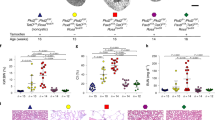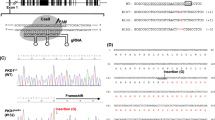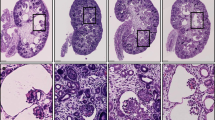Abstract
PKD2, mutations in which cause autosomal dominant polycystic kidney disease1 (ADPKD), encodes an integral membrane glycoprotein2 with similarity to calcium channel subunits1,3. We induced two mutations in the mouse homologue Pkd2 (ref.4): an unstable allele (WS25; hereafter denoted Pkd2WS25) that can undergo homologous-recombination–based somatic rearrangement to form a null allele; and a true null mutation (WS183; hereafter denoted Pkd2−). We examined these mutations to understand the function of polycystin-2, the protein product of Pkd2, and to provide evidence that kidney and liver cyst formation associated with Pkd2 deficiency occurs by a two-hit mechanism4,5,6,7,8,9. Pkd2−/− mice die in utero between embryonic day (E) 13.5 and parturition. They have structural defects in cardiac septation and cyst formation in maturing nephrons and pancreatic ducts. Pancreatic ductal cysts also occur in adult Pkd2WS25/− mice, suggesting that this clinical manifestation of ADPKD also occurs by a two-hit mechanism. As in human ADPKD, formation of kidney cysts in adult Pkd2WS25/− mice is associated with renal failure and early death (median survival, 65 weeks versus 94 weeks for controls). Adult Pkd2+/− mice have intermediate survival in the absence of cystic disease or renal failure, providing the first indication of a deleterious effect of haploinsufficiency at Pkd2on long-term survival. Our studies advance our understanding of the function of polycystin-2 in development and our mouse models recapitulate the complex human ADPKD phenotype.
This is a preview of subscription content, access via your institution
Access options
Subscribe to this journal
Receive 12 print issues and online access
$209.00 per year
only $17.42 per issue
Buy this article
- Purchase on Springer Link
- Instant access to full article PDF
Prices may be subject to local taxes which are calculated during checkout




Similar content being viewed by others
References
Mochizuki, T. et al. PKD2, a gene for polycystic kidney disease that encodes an integral membrane protein. Science 272, 1339–1342 (1996).
Cai, Y. et al. Identification and characterization of polycystin-2, the PKD2 gene product. J. Biol. Chem. 274, 28557–28565 (1999).
Chen, X.Z. et al. Polycystin-L is a calcium-regulated cation channel permeable to calcium ions. Nature 401, 383–386 (1999).
Wu, G. et al. Somatic inactivation of Pkd2 results in polycystic kidney disease. Cell 93, 177–188 (1998).
Qian, F., Watnick, T.J., Onunchic, L.F. & Germino, G.G. The molecular basis of focal cyst formation in human autosomal dominant polycystic kidney disease type I. Cell 87, 979–987 (1996).
Brasier, J.L. & Henske, E.P. Loss of the polycystic kidney disease (PKD1) region of chromosome 16p13 in renal cyst cells supports a loss-of-function model for cyst pathogenesis. J. Clin. Invest. 99, 194–199 (1997).
Koptides, M., Hadjimichael, C., Koupepidou, P., Pierides, A. & Constantinou, D.C. Germinal and somatic mutations in the PKD2 gene of renal cysts in autosomal dominant polycystic kidney disease. Hum. Mol. Genet. 8, 509–513 (1999).
Pei, Y. et al. Somatic PKD2 mutations in individual kidney and liver cysts support a “two-hit” model of cystogenesis in type 2 autosomal dominant polycystic kidney disease. J. Am. Soc. Nephrol. 10, 1524–1529 (1999).
Torra, R. et al. A loss-of-function model for cystogenesis in human autosomal dominant polycystic kidney disease type 2. Am. J. Hum. Genet. 65, 345–352 (1999).
Emmons, S. & Somlo, S. Mating, channels and kidney cysts. Nature 401, 339–340 (1999).
The International Polycystic Kidney Disease Consortium. Polycystic kidney disease: the complete structure of the PKD1 gene and its protein. Cell 81, 289–298 (1995).
Hughes, J. et al. The polycystic kidney disease 1 (PKD1) gene encodes a novel protein with multiple cell recognition domains. Nature Genet. 10, 151–160 (1995).
Qian, F. et al. PKD1 interacts with PKD2 through a probable coiled-coil domain. Nature Genet. 16, 179–183 (1997).
Tsiokas, L., Kim, E., Arnould, T., Sukhatme, V.P. & Walz, G. Homo- and heterodimeric interactions between the gene products of PKD1 and PKD2. Proc. Natl Acad. Sci USA 94, 6965–6970 (1997).
Markowitz, G.S. et al. Polycystin-2 expression is developmentally regulated. Am. J. Physiol. 277, F17–F25 (1999).
Gittes, G.K., Galante, P.E., Hanahan, D., Rutter, W.J. & Debase, H.T. Lineage-specific morphogenesis in the developing pancreas: role of mesenchymal factors. Development 122, 439–447 (1996).
Lu, W. et al. Perinatal lethality with kidney and pancreas defects in mice with a targeted Pkd1 mutation. Nature Genet. 17, 179–181 (1997).
Rossant, J. Mouse mutants and cardiac development: new molecular insights into cardiogenesis. Circ. Res. 78, 349–353 (1996).
Ranger, A.M. et al. The transcription factor NF-ATc is essential for cardiac valve formation. Nature 392, 186–190 (1998).
Clark, T.G. et al. The mammalian Tolloid-like 1 gene, Tll1, is necessary for normal septation and positioning of the heart. Development 126, 2631–2642 (1999).
Conway, S.J., Henderson, D.J., Kirby, M.L., Anderson, R.H. & Copp, A.J. Development of a lethal congenital heart defect in the splotch (Pax3) mutant mouse. Cardiovasc. Res. 36, 163–173 (1997).
Fishman, M.C. & Chien, K.R. Fashioning the vertebrate heart: earliest embryonic decisions. Development 124, 2099–2117 (1997).
Olson, E.N. & Srivastava, D. Molecular pathways controlling heart development. Science 272, 671–676 (1996).
Torra, R. et al. Ultrasonographic study of pancreatic cysts in autosomal dominant polycystic kidney disease. Clin. Nephrol. 47, 19–22 (1997).
Hateboer, N. et al. Comparison of phenotypes of polycystic kidney disease types 1 and 2. European PKD1-PKD2 Study Group. Lancet 353, 103–107 (1999).
Huston, J., Torres, V.E., Sulivan, P.P., Offord, K.P. & Wiebers, D.O. Value of magnetic resonance angiography for the detection of intracranial aneurysms in autosomal dominant polycystic kidney disease. J. Amer. Soc. Nephrol. 3, 1871–1877 (1993).
Bardaji, A. et al. Left ventricular mass and diastolic function in normotensive young adults with autosomal dominant polycystic kidney disease. Am. J. Kidney Dis. 32, 970–975 (1998).
Stockelman, M.G. et al. Chronic renal failure in a mouse model of human adenine phosphoribosyltransferase deficiency. Am. J. Physiol. 275, F154–F163 (1998).
Acknowledgements
We thank L. Ward for expert technical assistance; E. Burns and the Jacobi Medical Center Clinical Chemistry Labs for serum chemistry determinations; and M. Brueckner for helpful discussions. This work was supported by grants from the NIH (1R01 DK54053) and Albert Einstein Human Genome Program to S.S. and from the New York/New Jersey Affiliate of the National Kidney Foundation to G.S.M.
Author information
Authors and Affiliations
Corresponding author
Rights and permissions
About this article
Cite this article
Wu, G., Markowitz, G., Li, L. et al. Cardiac defects and renal failure in mice with targeted mutations in Pkd2. Nat Genet 24, 75–78 (2000). https://doi.org/10.1038/71724
Issue Date:
DOI: https://doi.org/10.1038/71724
This article is cited by
-
Mechanisms of endothelial flow sensing
Nature Cardiovascular Research (2023)
-
Radial pseudoaneurysm following coronary angiography in a patient with autosomal dominant polycystic kidney disease
Clinical Research in Cardiology (2023)
-
A change of heart: new roles for cilia in cardiac development and disease
Nature Reviews Cardiology (2022)
-
Smoking accelerates renal cystic disease and worsens cardiac phenotype in Pkd1-deficient mice
Scientific Reports (2021)
-
Ciliary exclusion of Polycystin-2 promotes kidney cystogenesis in an autosomal dominant polycystic kidney disease model
Nature Communications (2019)



